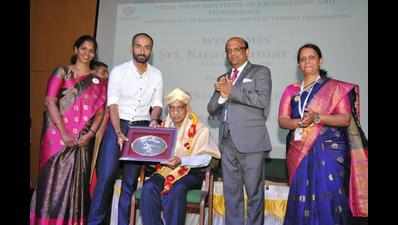- News
- City News
- mysuru News
- Former Isro chief recalls role played by Vikram Sarabhai in India’s space voyage
Trending
This story is from May 16, 2019
Former Isro chief recalls role played by Vikram Sarabhai in India’s space voyage
‘Determination, commitment and leadership’ was what India’s ambitious space programme had started with, and together, individuals who exemplified these virtues more than compensated for the complete lack of necessary infrastructure, said former chairman of the Indian Space Research Organisation (Isro) AS Kiran Kumar in Mysuru on Wednesday.

MYSURU: ‘Determination, commitment and leadership’ was what India’s ambitious space programme had started with, and together, individuals who exemplified these virtues more than compensated for the complete lack of necessary infrastructure, said former chairman of the Indian Space Research Organisation (Isro) AS Kiran Kumar in Mysuru on Wednesday. That India’s premier space agency was today independent as far as space infrastructure was concerned, Kumar added, spoke volumes about the contributions of Isro’s scientists and staff.
Kumar, who inaugurated ‘Varivas’ a space club started by the department of electrical and electronics engineering of Vidya Vikas Institute of Engineering and Technology, briefly outlined India’s space odyssey. Recounting an anecdote involving the pioneer of India’s space programme Vikram Sarabhai, Kumar said, “The assembly of the sounding rocket was organised at a church in Thiruvananthapuram, and Sarabhai had to convince the fishermen on the beach to vacate the place so that experiments could be conducted.”
Another of Sarabhai’s memorable achievements was the experiment he conducted over Indian longitudes, largely recognised as one of the biggest socio-technological experiments in the world. “For this, he had to persuade the powers in America to part with the Applications Technology Satellite-6, an advanced machine, for a year. Through this experiment, Sarabhai demonstrated in 2,400 villages how satellites circling around the Earth in space could help in the transmission of vital information. Black-and-white television sets from ECIL and set top boxes manufactured by the Space Application Centre in Ahmedabad were used for this experiment. This can be thought of an equivalent to modern-day DTH systems,” said Kumar, adding that it was this scientific adventure that convinced the government of India about the capabilities of space technology, and its applications in broadcasting, meteorology, et al.
Highlighting Sarabhai’s role in ushering in the remote sensing system, the former Isro chief said, “He borrowed a camera from NASA, and flew to Kerala, where the wilt disease had blighted coconut trees in vast areas of the state. He was eager to know how remote sensing could help prevent such an occurrence. It was only in the wake of this incident that Indian Remote Sensing Satellite Programme was approved.”
Kumar, who inaugurated ‘Varivas’ a space club started by the department of electrical and electronics engineering of Vidya Vikas Institute of Engineering and Technology, briefly outlined India’s space odyssey. Recounting an anecdote involving the pioneer of India’s space programme Vikram Sarabhai, Kumar said, “The assembly of the sounding rocket was organised at a church in Thiruvananthapuram, and Sarabhai had to convince the fishermen on the beach to vacate the place so that experiments could be conducted.”
Another of Sarabhai’s memorable achievements was the experiment he conducted over Indian longitudes, largely recognised as one of the biggest socio-technological experiments in the world. “For this, he had to persuade the powers in America to part with the Applications Technology Satellite-6, an advanced machine, for a year. Through this experiment, Sarabhai demonstrated in 2,400 villages how satellites circling around the Earth in space could help in the transmission of vital information. Black-and-white television sets from ECIL and set top boxes manufactured by the Space Application Centre in Ahmedabad were used for this experiment. This can be thought of an equivalent to modern-day DTH systems,” said Kumar, adding that it was this scientific adventure that convinced the government of India about the capabilities of space technology, and its applications in broadcasting, meteorology, et al.
Highlighting Sarabhai’s role in ushering in the remote sensing system, the former Isro chief said, “He borrowed a camera from NASA, and flew to Kerala, where the wilt disease had blighted coconut trees in vast areas of the state. He was eager to know how remote sensing could help prevent such an occurrence. It was only in the wake of this incident that Indian Remote Sensing Satellite Programme was approved.”
Expressing pride at the advancements made by the Indian space programme over the years, Kumar said, “Along with other areas, India gave equal importance to exploration of space. Starting from Aryabhatta to our Mars Mission and Chandrayaan II, India’s space agencies are creating new milestones.”
End of Article
FOLLOW US ON SOCIAL MEDIA










